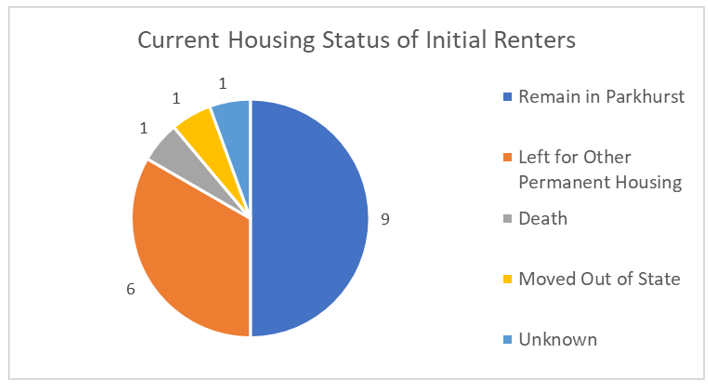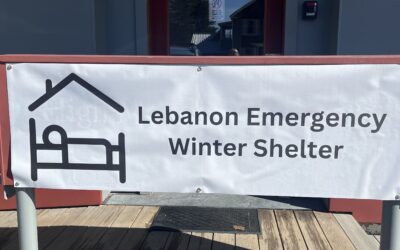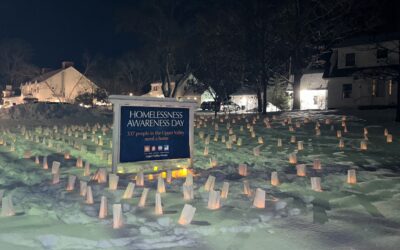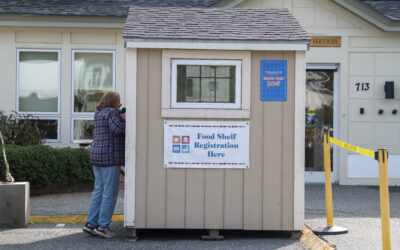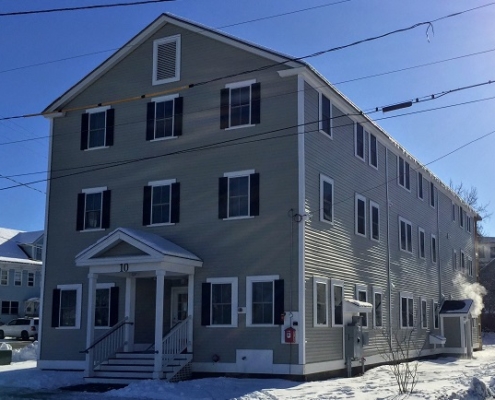
The Parkhurst Supportive Housing Project: A Review of Program Outcomes after 3 ½ Years
Michael Redmond, Executive Director, Upper Valley Haven
April 2022
Summary
This paper provides an analysis of the outcomes of a permanent supportive housing project in Lebanon, NH that opened in August 2018. The 18-unit apartment building, called Parkhurst Community Housing or simply, Parkhurst, provides rental units to people who have experienced chronic homelessness. A feature of the program is that residents of Parkhurst benefit from Project- Based Rental Assistance, with the tenant’s portion of the rent limited to 30% of their income.
Residents are eligible for Housing Choice Voucher (mobile voucher) after a year of successful tenancy, allowing a resident to move to other eligible properties if they choose.
Three and one-half years after opening the project can be viewed as very successful in meeting the goal of helping people remain housed. A total of 29 tenants have lived in the 18 units. Nine original tenants remain housed at Parkhurst and nine new tenants, all “chronically homeless” prior to moving to Parkhurst now live there. Of those who left, seven are now living in other permanent housing. One tenant has returned to temporary emergency housing and two have unknown status. Only one tenant was asked to leave due to disruptive behavior, though an eviction was avoided through counseling and a move to a housing environment more in line with his needs.
Introduction
The Parkhurst building in Lebanon, NH opened after a total renovation in August 2018. The owner, developer and manager of Parkhurst is Twin Pines Housing Trust, a non-profit affordable housing agency based in White River Junction, VT. Twin Pines Housing is the leading developer and provider of affordable housing in the Upper Connecticut River Valley region for individuals and families with low to moderate incomes. It has over 500 affordable apartments under management in the region.
The Parkhurst project was developed to be “supportive housing” for people who were “chronically homeless” under the definition of the U.S. Department of Housing & Urban Development (HUD). Included in this definition are people who are homeless with a disability who lives in a place not meant for human habitation, a safe haven, or in an emergency shelter, and have been homeless and living as described for at least 12 months* or on at least 4 separate occasions in the last 3 years. The definition of disability includes substance use disorder, serious mental illness, developmental disability, post-traumatic stress disorder, cognitive impairments resulting from brain injury, or chronic physical illness.
Permanent Supportive Housing (PSH) is permanent housing in which housing assistance (e.g., long- term leasing or rental assistance) and supportive services are provided to assist households with at least one member (adult or child) with a disability in achieving housing stability.
Twin Pines Housing entered into a Memorandum of Understanding with the Upper Valley Haven, a non-profit organization based in White River Junction that provides shelter to unhoused individuals and families and provides community outreach and supportive services to people experiencing homelessness and housing insecurity. Once completed, the Haven agreed to provide the supportive services in the supportive housing model by assigning a service coordinator to this project. Tenants would be able to voluntarily decide if they wanted to work with the Haven service coordinator. The Dartmouth Hitchcock Medical Center Population Health Program has provided financial support for the Haven towards the expenses of this supportive housing service.
A unique feature of the Parkhurst project was that not only would tenants have Project-Based rental assistance support in which they would pay no more than 30% of their income for rent, if they remained successfully housed after 1 year, they would be eligible for a Housing Choice Voucher that would allow them to apply for subsidized housing anywhere in New Hampshire. After 2 years of successful housing this voucher offer would include eligibility for a unit in the entire U.S. (N.B., the voucher is permanent for the tenant, but landlords have some discretion in choosing to accept vouchers or accept the tenant with the voucher. Different rules apply in different states.)
Demographic Profile
While a common image of “chronically homeless” individuals is young men, the experience at Parkhurst varies dramatically from that stereotype. Looking at the current Parkhurst residents, 17 apartments are occupied by single adult and one by a couple. Of the total 19 residents, six (32%) are women and 13 (68% are men. Current tenants range in age from 42-81; 12 of the 19 are in their 50s (63%) and 26% (5) are in their 40’s
Initial Rent-Up
When the building opened in August 2018 the new tenants had multiple previous places of residence. The largest number, 12, were from the Haven’s Hixon Adult Shelter. The Haven service coordinators helped Hixon guests with applications and documentation. Two additional new tenants were living in the community (one in his car) and were working with Haven service coordinators.
Two were previous Parkhurst tenants prior to the renovation, and another lived in a different Twin Pines property but met eligibility requirements. One entered from the New Hampshire Housing Finance Authority wait list.

Total History of Where Tenants Lived Before Moving to Parkhurst
As noted above, some turnover in the Parkhurst apartments has occurred since it opened in August 2018. A total of 29 tenants have lived in the 18 apartments. By far, most of the tenants were from the Haven’s Hixon Shelter (17) or were living in the community and working with a Haven service coordinator (7). Of the remaining five, two lived in Parkhurst before the renovation, 1 came from another Twin Pines property and two applied through the NH Housing Finance Agency.

Role of Supportive Housing Services
Of the 29 total residents at Parkhurst, 27 (93%) have engaged with a Haven service coordinator for some period of time and at some level of intensity based on their needs and willingness to work with the service coordinator. We used three levels of engagement to characterize our work – low, medium and high. We made judgments about the length of time and intensity of service time in the engagements. We estimated that six (23%) were “basic”, 12 (46%) were “intermediate” and 8 (31%) were “intense”.
Housing Stability
The tenants who have lived at Parkhurst since the renovation have had very positive outcomes. Considering that nearly all tenants qualified as “chronic homeless” prior to moving into Parkhurst (only the tenants who lived at Parkhurst or another Twin Pines property prior to the renovation did not meet this definition), these outcomes are commendable.

With most tenants engaged at some level with the Haven, any variation with those tenants who chose not to engage with the Haven was not meaningful due to the small number. For those engaged with the Haven, 90% have had a positive housing status to date – either still living at Parkhurst or they left Parkhurst for another housing placement.
Current Housing Status of Original Renters
Nine of the original renters remain in Parkhurst to this day. Of the other nine, 6 moved into other permanent housing. Three of these six secured Housing Choice Vouchers and moved into larger apartments and were able to keep their rent at 30% of income. Two other tenants found the Parkhurst apartments too small and left to live with significant others in the community. One determined she needed a more supportive environment and left for another program. One passed away due to illness. One left Parkhurst because she found the stairs challenging and moved to be closer to family in another state. One former tenant’s housing status is unknown.
Status of the Haven Clients
Examining only the Parkhurst tenants who were Haven clients prior to moving to Parkhurst, we find the same pattern of success. The role of the supportive housing model – affordable housing and supportive services — have certainly been key to their success. Of the total 24 tenants connected with the Haven, 15 remain housed at Parkhurst, 7 are living in other permanent housing, 1 has returned to emergency shelter and 1 was evicted.
| Housing Status Prior to Parkhurst | |||
|
Current Status of Haven Clients |
Moved from Hixon |
Moved from Community |
Total |
| Living in Parkhurst | 12 | 3 | 15 |
| Evicted | 0 | 1 | 1 |
| Living in Other Permanent Housing including Other Twin Pines Apartments | 5 | 2 | 7 |
| Temporary/Emergency Hsg | 0 | 1 | 1 |
| Unknown | 0 | 0 | 0 |
| Total | 17 | 7 | 24 |
Conclusion
The Parkhurst supportive housing project has been very successful. Despite nearly all of the tenants qualifying as “chronic homeless” according to the HUD definition, there have been very positive outcomes to date. The large majority continue to live in Parkhurst or have been able to move and obtain permanent housing in another location. The availability of case management services provided by the Haven, rents at affordable levels (maximum of 30% of revenue) and rent vouchers that are transferable after one or two years of steady rental histories are certainly contributing factors to this success.


